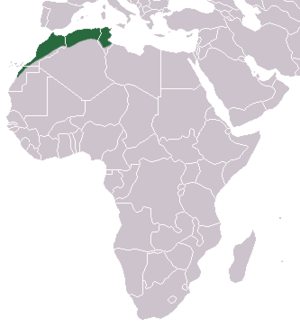Whitaker's shrew facts for kids
Quick facts for kids Whitaker's Shrew |
|
|---|---|
| Conservation status | |
| Scientific classification | |
| Genus: |
Crocidura
|
| Species: |
whitakeri
|
 |
|
| Whitaker's Shrew range | |
The Whitaker's shrew (Crocidura whitakeri) is a tiny mammal. It belongs to the shrew family, called Soricidae. You can find this small creature in parts of North Africa. This includes Western Sahara, Algeria, Morocco, and Tunisia.
Whitaker's shrews like to live in dry, bushy areas. They also live near rocky and sandy coasts. They are quite common. Because of this, experts say they are a "least concern" species. This means they are not currently in danger of disappearing.
About Whitaker's Shrew
The Whitaker's shrew is a small, light-colored animal. Its head and body are about 61 mm (2.4 in) long. Its tail adds another 33 mm (1.3 in). It has a larger head and ears compared to some other shrews. For example, it's bigger than the greater white-toothed shrew.
Its fur is short and feels very soft. The top part of its body is a light brown color. It has tiny white specks. Each hair has a grey base, a white band, and a brown tip. The underside of the shrew is whitish. These hairs are grey at the bottom and white at the top. Its feet are pale on both sides. The tail is light-colored on top and white underneath.
Where Whitaker's Shrew Lives
Whitaker's shrew lives in several North African countries. These are Western Sahara, Morocco, Algeria, and Tunisia. You can find them from sea level up to 1,800 m (5,906 ft) high. This includes the Atlas Mountains.
They live in many different places. These include stony, open areas and semi-deserts. They also like places with a few scattered bushes. You can even find them on sandy coastal dunes. They are common on the Atlantic coast of Morocco. However, they are not as common on the coastal areas of Algeria.
Life and Habits of Whitaker's Shrew
We don't know a lot about the daily life of this shrew. We don't know much about what it eats or how it has babies. It is mostly active at night, which means it is nocturnal. During the day, it hides in burrows made by other animals. It also uses cracks in rocks to stay safe.
The main animal that hunts Whitaker's shrews is the barn owl (Tyto alba). You can often find shrew remains in owl pellets. These are small, undigested balls of food that owls spit up. Other birds that hunt this shrew include the pharaoh eagle-owl (Bubo ascalaphus). The tawny owl (Strix aluco) and the black-winged kite (Elanus caeruleus) also hunt them.


